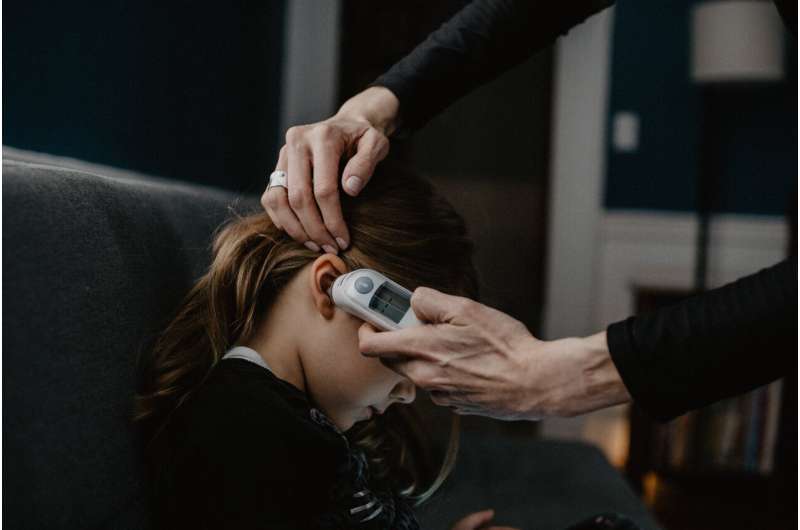by Friederike Fellenberg, NAKO e.V. / NAKO Gesundheitsstudie

Scientists at the University Medical Center Hamburg-Eppendorf (UKE) and Heidelberg University Hospital (UKHD) have investigated potential risk factors for multiple sclerosis (MS) in childhood and adolescence as part of the German National Cohort (NAKO).
Their analysis, published in the journal Deutsches Ärzteblatt international, shows that frequent infections in childhood, major stressful life events, higher maternal age at first birth and low physical activity might be associated with an increased risk of MS. At the same time, the study confirmed already known risk factors for the disease.
MS is an inflammatory disease of the central nervous system and can significantly impair the quality of life of those affected.
“The causes of MS are still mostly unknown. Some studies suggest that environmental and lifestyle factors can induce the development of disease in genetically predisposed people. Known risk factors include a genetic predisposition, an infection with the Epstein-Barr virus, a vitamin D deficiency, smoking and obesity. Influences from childhood and adolescence have so far been less well studied,” reports Professor Dr. Heiko Becher from the Institute of Global Health at Heidelberg University Hospital (UKHD).
The current study is a case-control study nested into the NAKO. NAKO participants with and without MS were asked about risk factors in the additional study.
Factors of particular interest included prenatal factors, infectious diseases in childhood, time spent outdoors in childhood and adolescence, physical activity in the teenage years, body mass index (BMI) at the age of 18, stressful life events and smoking behavior.
In total, data from 576 people who self-reported a medically confirmed diagnosis of MS (396 women and 180 men) and 895 control subjects without MS (638 women and 257 men) were included in the analysis.
The control group consisted of randomly selected people without MS who were individually matched to a person with MS based on their year of birth, sex and study center.
The researchers used statistical models to analyze which factors are associated with an increased risk of MS in childhood and adolescence. The so-called odds ratio (OR) indicates how strong the association is compared to the control group: a value below 1 indicates a lower risk, a value above 1 an increased risk.
The results showed associations between MS and childhood infections (OR=1.14 per additional infection), stressful life events (OR 1.25 per additional event), being the first-born child of a mother 30 years or older at birth (OR = 2.11) and physical activity in adolescence (OR=0.82 per increase in activity level)—in this case, however, in the opposite direction, i.e. with a lower risk with more exercise.
The study also confirmed already known risk factors, including a family history of the disease, an infection with the Epstein-Barr virus and being overweight or obese as a child or adolescent.
However, no associations were found for any of the other factors analyzed, including having a serious illness (with the exception of MS), passive smoking—i.e. parental smoking during pregnancy and in the participant’s childhood and adolescence—or time spent outdoors.
“Our results underline the relevance of existing preventive measures in the context of other non-communicable diseases—for example, to prevent childhood infectious diseases, to encourage healthy eating habits or to motivate people to be active,” says Anja Holz, first author and scientist at the Institute of Medical Biometry and Epidemiology at the UKE.
“These could also be promising strategies in MS prevention. One particularly impressive example is physical activity: current studies show that exercise in adulthood can act as a protective factor against MS. Targeted physical activity programs in adolescence might also potentially help to lower the risk of MS.”
In addition, the findings provide a basis for further studies, for example, on the question of whether and to what extent the newly identified risk factors are associated with the severity of the disease.
More information:
Anja Holz et al, Findings of a case–control study nested within the German National Cohort (NAKO) study, Deutsches Ärzteblatt international (2025). DOI: 10.3238/arztebl.m2025.0069
Provided by
NAKO e.V. / NAKO Gesundheitsstudie
Citation:
Multiple sclerosis research focuses on the early years of life (2025, May 30)
retrieved 31 May 2025
from https://medicalxpress.com/news/2025-05-multiple-sclerosis-focuses-early-years.html
This document is subject to copyright. Apart from any fair dealing for the purpose of private study or research, no
part may be reproduced without the written permission. The content is provided for information purposes only.

